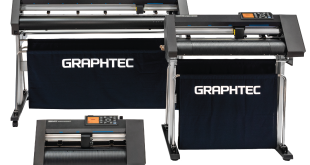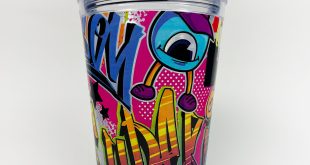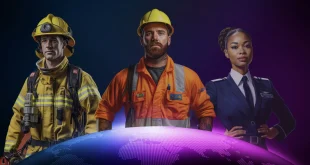 From across the pond, Andrea Bommarito, ZSK Machines in St Louis, USA, provides an interesting insight into how the single-head embroidery machine has evolved over time to what it is today.
From across the pond, Andrea Bommarito, ZSK Machines in St Louis, USA, provides an interesting insight into how the single-head embroidery machine has evolved over time to what it is today.
The simple definition of a single head embroidery machine is a machine that produce one embroidery piece per operation.
Although this may not seem impressive compared to the large, multi-head equipment, the single-head embroidery machine is one of the most popular models in the US for embroidery embellishment because of its flexibility and versatility.
A brief history
In the history of embroidery equipment, the single-head model did not evolve until the late 1970s and, even then, did not make a significant impact on the market. It was not until the mid to late 1990s that this type of equipment created a huge impression.
Most embroidery businesses in the United States operated with several large pieces of multi-head equipment for the mass production. Imagine that during this time, 16- and 20-head machines were standard models, and the four- and six-head machines were considered small units.
The single-head did not exist until the 1980s, and even then, it wasn’t well-received. The cost of a single-head machine was one and a half to two times (or more) the price per head compared to multi-head equipment. Plus, the market norm was producing hundreds to thousands of pieces at a time, so why would a single-head be considered a good investment? The need for smaller orders and sample items started to emerge as mass production went over-seas. The changing economics forged a new embroidery market for the single-head and started a revolution in equipment.
The mighty single-head
The single-head may be the favoured model because of its adaptability. For example, in the large shops, it’s the proof or sample machine used to run designs to ensure quality and efficiency before moving on to production. For the medium shops, it’s for the smaller orders and personalisation to reserve the multi-head equipment for the big orders. For the smaller shops, its for all the above and more.
But, to be fair, these are strong blanket statements that do not ring completely true for all shops. In fact, several large companies operate with hundreds of single-heads and no multi-heads.
A single-head is a single-head?
Single-heads are not all the same. Yes, they all have the capability of producing one piece at a time, but there’s more to it than just that. The structural design of the machine plays a significant role in capability, longevity, and overall performance. I’ve loosely classified these into three main types.
One type of single-head available on the market today is a smaller, hobby-enthusiast machine. I define it more as a cross-over compact embroidery machine where a home embroidery machine meets an industrial machine. This type of machine can range from one to 10 needles with the ability to stitch on finished garments (tubular). It has a small footprint and a lighter weight style (e.g. plastic housing and parts, lighter duty motors). I do not classify it as an industrial machine as it does not have the industrial jump structure. Also, this is a small arm-style built that looks like a conventional sewing machine from the side and has an obstruction point behind the pantograph assembly. This type of machine has a lot of capability but is limited to certain specifications. So, it’s only fair to compare it to other similarly built equipment.
Another single-head type is a compact industrial embroidery machine. This style is space-conscious by offering a smaller footprint and seems to be the most popular model for entry-level embroiderers. Most compact style machines are built with a medium arm-style frame, which allows for larger stitch area than the cross-over compact embroidery machine, but still has that obstruction point in the back of the pantograph. Besides the arm-style, there is a compact bridge-style model available that has an open back (no obstruction behind the pantograph). The bridge structure provides a more stable framework for the machine. It should be noted that multi-head embroidery machines are also built in this fashion.
The full-size single-head type typically has the most significant field size of the different offerings available. Most manufacturers produce both large arm-style frames or bridge-style frames. This type of equipment has a larger footprint and is heavier duty than the compact single-head embroidery machine.
Dive deep
There are several different models available in both the compact and full-size industrial single-head type machines. It can be from the number of needles to embroidery field size to accessory capability (e.g. sequins, beading, cording, etc.) to speciality applications and more.
Besides the wide range of models available, single-heads are flexible and can adapt jobs faster than a multi-head. Changeover can prove to be burdensome for a large multi-head (e.g. changing thread colours, changing needles or changing from tubular to caps) but this is much faster on a single-head because of the size alone. In the on-demand market (high production, small order size), the single-head machine is the preferred model because of flexibility. Online shops that embroider shirts and caps, offer no minimums and typical order sizes are one to three pieces have a warehouse full of single-heads. It’s a new business model that has proven to be quite successful all over the world.
The custom home-décor and automotive/aerospace/yacht interiors market have also made a big impact in the embroidery world. The full-size single heads offer a new way to personalise these goods. Much of this speciality work requires a substantial embroidery field as well as specialty options (e.g. boring, cutwork, upholstery stitching, etc.). Many times, the full-size single-head type will fulfil these needs since there are many different models available that can accommodate the various options. The single-head is more attractive in this case, as each order is unique.
Overall, single-head equipment offers impressive capabilities across the board and can fulfil specific needs for different business models. It’s imperative to study each machine’s capabilities, from the brand to the types of models available.
Performance
Features are important, especially when looking into the different models of single-head, but the performance and longevity of the machine are critical. The efficiency, speed and precision of a machine affects the bottom line. The more quality product that goes out the door; the more capital comes in. Understanding production speed, build quality and machine features give insight as to what can and cannot be decorated. For example, embroidering on raw cowhide or rigid leather shoes is achievable, but not all machines have this ability simply because the internal components are inadequate.
So, what can you expect out of a single-head? This is a great question, and I always must take a step back in explaining that there is not a blanket answer. My response is, ‘it depends’. By participating in the various online groups and communities, many people will pose the question, ‘which single-head should I get?’ Well, that is a loaded question as there are so many variables one must research to weigh the options. One person may love a compact, industrial machine for their business. Another person may state that there is no other way to go than a full-size industrial single-head. Talk with a machine representative (or an engaged embroiderer) that has a rich history in the industry to aid you in equipment research. Any great salesperson will ask questions to reveal your business needs and explain the different offerings to fit you with the right equipment.
 Longevity
Longevity
Most embroiderers hold on to their single-head(s) when adding equipment because of its versatility, and because of this, they want to keep it for a long time. Some embroidery machines may see a decline in performance over time, which affects the longevity of the equipment. The machine’s internal machines and electronics are important to examine. The days and years of use can diminish the machine’s efficiency as the wear and tear on certain parts occur. Each manufacturer builds machines differently; which will indicate the lifespan of the equipment. It’s also important to look at the electronic components and controllers as technology evolves much faster than mechanical improvements.
In the history of embroidery equipment, the single-head model is much younger and more popular than its counterparts. Since its existence, the single-head expanded into many new aspects of the industry and created unique niche markets that continue to flourish. Development by the manufacturers continue to evolve to propel the capability of this model. There’s definitely more to a single-head than one garment at a time.
Stocks Sewing Machines is the sole UK distributor for ZSK Industrial single-head and multi-head embroidery equipment.
 Printwear & Promotion The Total Promotional Package
Printwear & Promotion The Total Promotional Package




